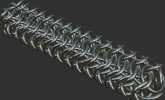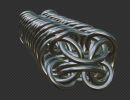I was fooling around recently, and I made a weave that I have not seen described before.
Using two aspect ratios of the same diameter of wire (20 gauge, i believe swg, but I'm not certain), inner diameter of 1/8th inch and 3/16ths inch.
I made the jump rings myself, so there may be a bit of a wider inner diameter due to the tolerance from winding.
As a description of the pattern, the geometry of the pattern is rotationally symmetrical at 180 degrees, with alternating columns of the larger rings, each large ring being connected to six (four small, two large) other rings. It can be constructed by taking three 2-in-1 chains (rows) of the larger rings, laying them parallel to each other with the adjacent (column-wise) ring of the next chain overlapping and parallel. then, through the eyes of the larger rings, connect each adjacent pair of rings in a column to the pair in the next column using the smaller rings. each smaller ring should end up linked through 4 larger rings, with the axis of rotation of each smaller ring fitting between each column, parallel to the plane made by the sheet.
Sorry if that was a poor explanation. I will attach a picture.
Due to the geometry of the weave, it can be made into a chain at ether of 90 degree orientations.
Using two aspect ratios of the same diameter of wire (20 gauge, i believe swg, but I'm not certain), inner diameter of 1/8th inch and 3/16ths inch.
I made the jump rings myself, so there may be a bit of a wider inner diameter due to the tolerance from winding.
As a description of the pattern, the geometry of the pattern is rotationally symmetrical at 180 degrees, with alternating columns of the larger rings, each large ring being connected to six (four small, two large) other rings. It can be constructed by taking three 2-in-1 chains (rows) of the larger rings, laying them parallel to each other with the adjacent (column-wise) ring of the next chain overlapping and parallel. then, through the eyes of the larger rings, connect each adjacent pair of rings in a column to the pair in the next column using the smaller rings. each smaller ring should end up linked through 4 larger rings, with the axis of rotation of each smaller ring fitting between each column, parallel to the plane made by the sheet.
Sorry if that was a poor explanation. I will attach a picture.
Due to the geometry of the weave, it can be made into a chain at ether of 90 degree orientations.





